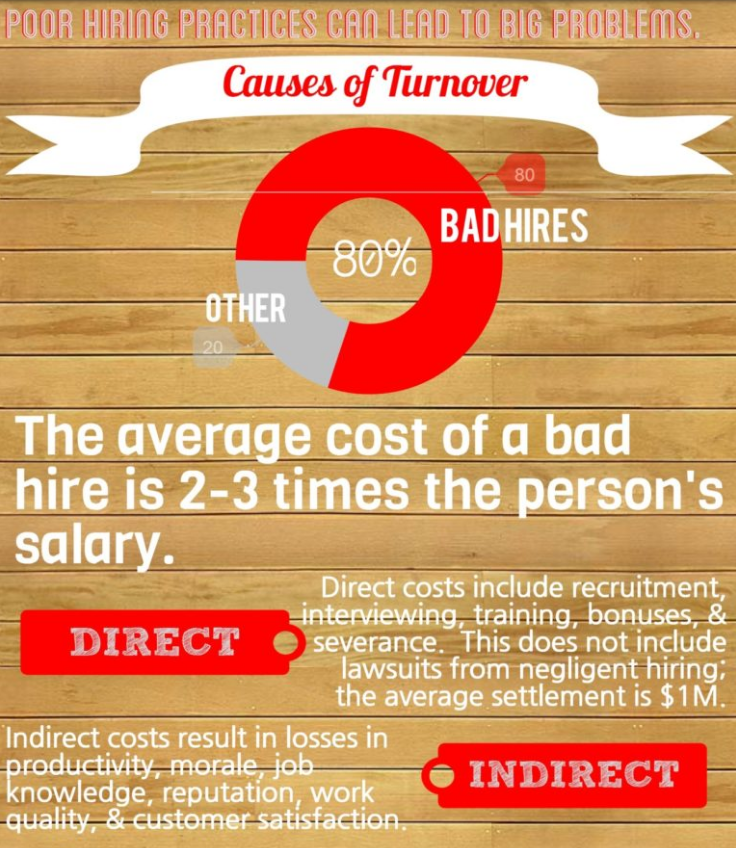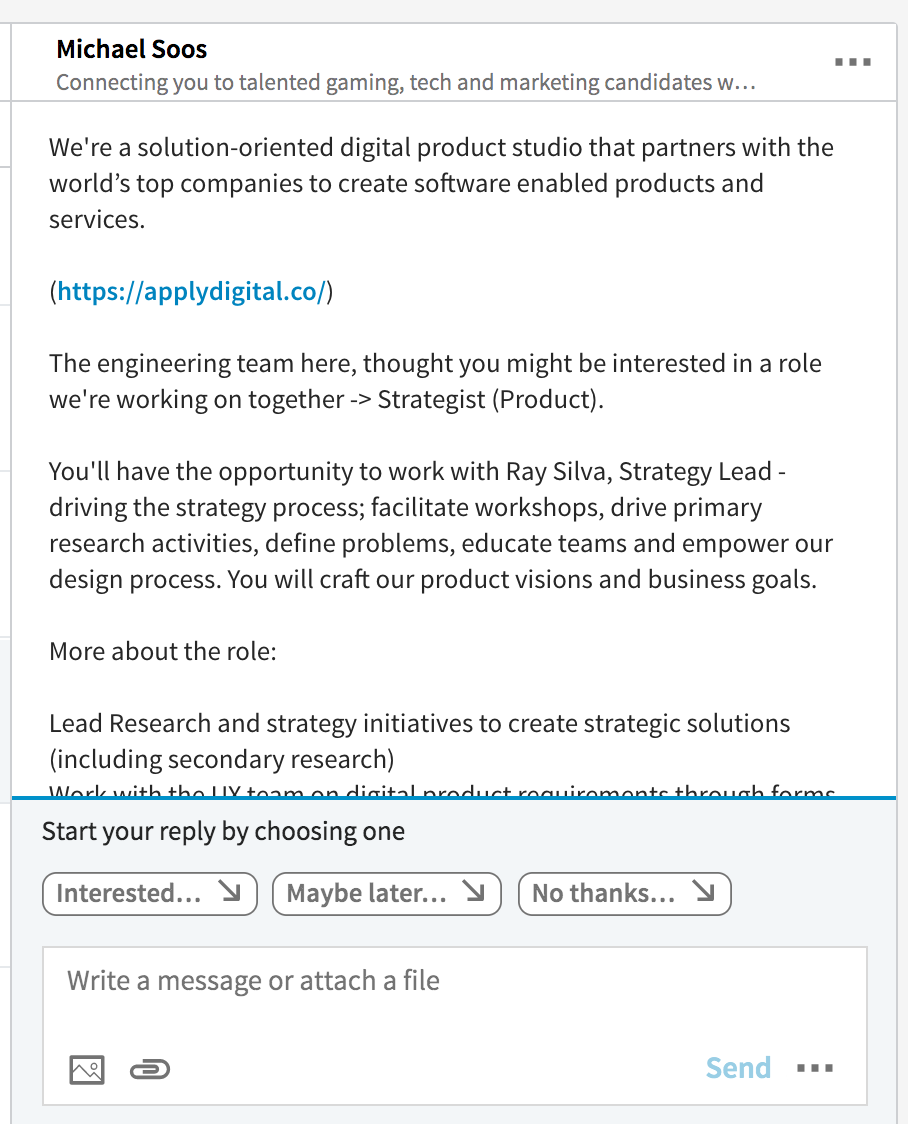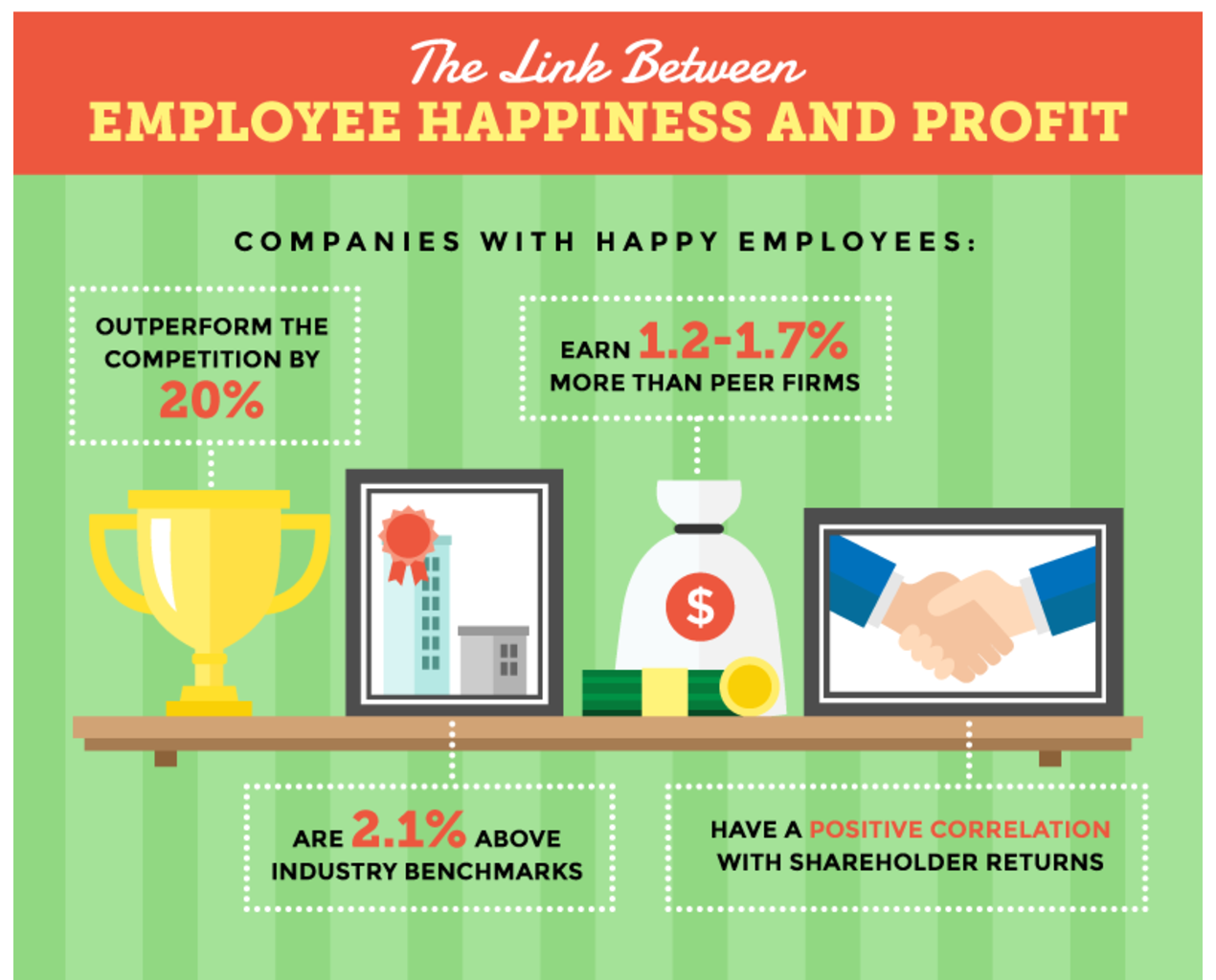If there’s one thing the Internet hasn’t totally revolutionized, it’s the hiring process.
Hiring new employees is still based on the same old system.
Create a job advertisement, do an interview or three, call references, think about it, make an offer, wait for the candidate to think about it, and hire the new employee.
All of that takes a lot of time and resources.
And if you get it wrong? A bad hire can cost your company a lot of money.
For 41% of employers who made a bad hire, it costs them over $25,000.
If you hire the wrong person, you don’t just have to cough up the expense of replacing them.
Some of your best performers might leave when they get too frustrated by their underperforming co-workers.
There is an easier way to ensure you’re hiring star-quality employees.
I’ve grown my team from no one to several dozen people in the span of a few years.
This kind of rapid growth would not be possible without a fast, reliable system to find the best people and get them on board.
When I started building my team, I applied my knowledge of Internet marketing tactics to the hiring process.
By learning some basic marketing skills, you can speed up your hiring process and end up with talented employees in a fraction of the time it used to take.
Here are my best strategies for growth hacking your next hire!
What does growth hacking mean?
But first, what does it mean to “growth hack” something?
Growth hacking is a term used in marketing circles. It means that everything you do has one specific goal: Grow your user base.
Think of it like marketing on steroids.
Traditional marketing involves growing users through acquisition. It also includes other things like brand management, corporate revenue goals, and long-term planning.
Growth hacking relies on quick action and learning from data to change your strategy and reach even more people.
The sole focus of growth hacking is to get new users for your product or service, or new readers for your website.
When it comes to hiring, think of growth hacking as a way to become laser focused on finding only the very best people.
And doing that very quickly.
Sounds like what you want to do, right?
Poach the best talent from other companies
A good source of talented individuals are people who already have jobs.
It sounds funny, but I’m serious!
Why wait for people to apply to your listing when you can go out and approach them?
Known as “head-hunting” or “recruiting”, this practice of stealing talent from other employers has been around forever.
In fact, 85% of jobs are filled through networking or referrals!
But now, the Internet makes it easier than ever.
A great tool for this process is LinkedIn. This social network for professionals has almost 500,000 members of which 90% are open to hearing from a recruiter.
The site has a large job-listing section, but its true power lies in LinkedIn’s Recruiter subscription.
With a Recruiter profile, you can search for candidates who match your specifications. This includes people who are already employed but are open to changing jobs.
When you browse profiles with a Recruiter profile, your name doesn’t show up to the person whose profile you’re browsing.
This is an effective way of hunting for candidates without exposing who you are.
When you view a profile, you’ll show up as “Recruiter” in their statistics, like this:
With the subscription, you also get 30 InMails (LinkedIn’s version of email) per month.
This allows you to send messages to people you aren’t connected with. You can let them know what position you’re hiring for and ask them to click a link to apply. You can also invite them to your message.
The person who receives the message can type a reply or select one of LinkedIn’s pre-written options.
If you’re not sure how to use LinkedIn to find good candidates, check out this video.
The tips I share in it apply to finding customer leads and job candidates.
Use a recruitment agency
One of the hardest things to accept as an entrepreneur is how little time you actually have.
You may think you have time to handle hiring team members, but most likely, you don’t.
You could spend that time doing more important things for your company.
You could work on your personal content marketing strategy or plan your big-picture goals.
Handing off the hiring process to someone else can be a huge time saver if you have the budget for it.
Most recruiters work on a per-hire basis, meaning that they get paid when you hire one of their candidates. Many have a policy of ensuring that person passes their three-month probationary period before taking payment.
The fee for using a recruiter can be all over the map, but it is typically a percentage of the annual salary of the job you’re advertising for.
So if you want to hire a marketing specialist for $50,000 per year, a recruiter’s fee may be 25% of that person’s annual salary. This means you would owe the agency $12,500 for filling the position.
It can seem like a lot of money, but if you’re trying to find a very specific type of person, it can pay off in the long run.
The best way to be successful with recruiters is to find one that specializes in your industry. You can do a simple Google search for “your industry + recruiter + your location” to get some options.
These results are all recruitment agencies.
There are some big benefits to using a recruiter for your employee search.
It saves you time.
Recruiters will advertise the position and proactively seek out candidates from their own talent pool. They also perform the first screening interview.
This means that the only candidates you have to interview are those who made it past all the typical first steps.
Instead of having to deal with all applicants, you get to jump ahead a few steps to screen just the qualified candidates.
Money-back guarantee.
Most recruitment agencies offer a refund if their placement quits or is fired during a certain time period. For 84% of agencies, that’s somewhere between 30 and 90 days.
That’s about the same time as the typical three-month probationary period you have when hiring a new candidate anyway (depending on where you live).
You really don’t have anything to lose by giving a recruiter a try.
There are, however, a few drawbacks to using a recruiter besides the hefty price tag.
It can harm your brand.
Choosing the right recruiter to partner with is really important.
How candidates are treated during the early screening process can affect what they think of your brand.
60% of job candidates have had a poor hiring experience in the past. 64% of candidates say a poor experience makes them less likely to be a customer of that company later on.
In other words, a bad agency might not just poison the talent pool. It could also hurt your revenue by turning potential customers against your brand.
Make sure you’re partnering with an agency that knows your core values and how much you value respect.
It can be slow and inefficient.
Some recruitment firms haven’t stepped into the current century yet when it comes to closing deals.
We’re in a job seekers’ market.
Thanks to some economic stability and low unemployment rates in recent years, employees now hold more cards than employers.
With all the competition out there for good talent, you need to act quickly to secure the very best candidates. If you don’t, you risk them finding a better offer elsewhere.
A recruiter screens candidates before they even reach you. That takes time.
The recruiter has to set up a phone interview with the candidate, maybe even twice, then type up and provide you with a summary of their thoughts on the candidate.
That could take a week.
Then you might take a few days to review it before saying, “Yes, I want to meet this person!” The recruiter then has to schedule an in-person meeting, which could take a few days.
You see where this is going.
Nowhere fast!
The average interview process could take as long as 23 days.
Anytime during those 23 days, a candidate could get a response for a job they applied for the previous week before even talking to you, and decide to take the offer.
You need to act fast. Some recruiters do, and others don’t.
Use recruiting software to save time
If the cost of hiring a recruiter doesn’t work for you, or you want to keep hiring internal, recruiting software could be the answer.
Think about all the research you have to do with a candidate.
Glancing through a single resume might take 5-10 minutes.
You probably check candidates out on LinkedIn or Facebook, too, since 41% of employers say they won’t hire someone if they can’t find them online.
There are the phone interview and prep time, which can typically take an hour or so.
Then add in one or two in-person interviews at an hour each.
That adds up to about 4 hours and 10 minutes per candidate!
Workable is an online platform that’s trying to change that.
There are some extreme time-saving benefits to using a tool like Workable.
Add new jobs to your website easily.
When you add a new role in Workable, it automatically publishes it on your corporate website. You don’t need to get IT or your marketing team involved to keep it up to date.
Post on multiple job boards.
You can automatically post your job ad on popular job boards like Monster, Indeed, StackOverflow, and more.
Find all their social profiles automatically.
The tool searches through social media to automatically connect an applicant to his or her profile. This saves you tons of research time.
With Workable, you can also see your pipeline in real time. You’ll know how many applicants you have and where they are in the hiring process.
Plus, you can schedule interviews easily with built-in integrations with calendars and email service providers. No more emailing back and forth with potential dates and times.
Okay, there’s one more really cool thing.
Workable even features an interview-evaluation tool where you can write all your notes about a candidate and share them with the rest of your staff.
There are lots of other recruitment software options out there to help automate and speed up your hiring process.
Ask for references and work samples up front
In case it hasn’t sunken in yet, you need to act fast when making a hiring decision.
39% of employers cite competition as a primary obstacle to hiring.
So why are you leaving out important details in your job ad?
By that, I mean asking for references and samples of work right away in your ad.
Many employers wait to ask for this information until after they’ve already had a phone or in-person interview with a candidate.
To me, that’s like waiting for the water to get up to six feet in your house before you start to think, “Hmm, maybe it’s a flood.”
By the time you’re done interviewing someone, it could be too late to wait for them to send you their samples.
They could get another offer and be gone before you even ask.
If you’re serious enough about a candidate to interview them, you should find out if they can really have the skills you need.
Here’s an example of what PolicyStat asks their candidates to do:
You might this is a bit of overkill, but it can save you a lot of wasted time later on.
I don’t believe in making people work for free. You should offer these tests as paid assignments to candidates you’re serious about.
Offering a paid test shows that you value and respect their time and sends a good message about your corporate culture.
Same goes with references!
In your job ad, ask candidates to include 2-3 references with their applications.
It will save you a lot of time during your decision phase. It often takes a few calls to reach a reference, which can add a few more days to the process than you were expecting.
Make a list of non-negotiables (and stick to it)
Before you start interviewing anyone, make a list of the qualities your employees absolutely need to have.
This list ensures that you hire people who will mesh well with your corporate culture.
Corporate culture isn’t just another buzzword people use to attract millennials to their companies. It’s important.
Your company’s culture guides everything from acceptable behavior standards for employees to how senior leadership makes decisions.
It’s not just when you’re open, what your dress code is, or your list of core values. It’s the unwritten rules that govern how your workplace functions.
Chipotle famously has a list of 13 characteristics that every single team member must have, including things like being “polite, presentable, and curious.”
Companies with happy employees make 20% more money than their competitors.
Making sure you’re hiring people who will be a good fit also decreases the rate of employee turnover, which averages about 10-15%, depending on your industry.
Your list of must-have skills or personality traits should influence every hiring decision.
Refer to it often and make sure every candidate meets the criteria.
Don’t skip something just because the person looks good on paper or has a strong skill set. If a candidate leaves his or her interview, and you’re not impressed by that person’s personality or skill set, move on.
Above all, stick to your list!
Have a training plan ready on day one
There’s nothing worse than getting hired at a new job and showing up on the first day with nothing to do.
Your new hire may start to think they made the wrong decision if you’re not organized and ready for them when they start.
In fact, almost half of millennials surveyed in a recent study said they’d consider going back to a former employer.
When looking for a new job, there’s the feeling of the grass being greener on the other side.
If that doesn’t turn out to be true, your new hires could change their minds and walk right back to their desks…at their old jobs.
Your training plan should have these key elements:
Job description
Your new hires should be given copies of their job descriptions to refer back to as they learn their new responsibilities. This ensures you’re both on the same page.
Corporate goals
Write down your main corporate goals and how you’re trying to get there. Keep it brief.
This will give your new hires an idea of what you’re trying to achieve and how their work fits into that.
Personal development milestones
Lay out the work schedule for next few weeks or months for your new employees. This should be what you expect them to be able to do by week three, seven, twelve, or whatever amount of time is appropriate.
Having a written list of expectations lets your employees know exactly what they need to do. It makes sure nothing gets lost in translation or confused.
Check-in dates
Establish dates when you will check in with your new hires to evaluate their progress so far. Also, let them know that they can ask questions.
Think of these meetings as informal coaching sessions that help your new hires get up-to-speed quickly.
What your plan looks like will vary depending on the job. To keep it simple, just write down the skills they need to learn as a list.
You know the old saying, “If you fail to plan, you plan to fail!”
It’s definitely true when it comes to managing your new employees.
Conclusion
It can be difficult to find talented employees.
Especially now, with more roles requiring highly specific skills and knowledge, like software developers and marketers.
Whether you decide to hire on your own or use a recruiter, don’t skip culture fit.
Letting people into your organization who don’t fit well with your core values will only cost you time, money, and good employees in the long run.
Don’t hire someone just because they’re talented.
Hire talented people who are also passionate and determined. Make sure they work well with the rest of your team. Plus, screen them for whatever other attributes you’ve come up with on your ‘must-have list’.
Use technology to help you.
There are tons of software solutions out there to save you time researching and finding candidates. Use them!
Some of them even let you create job-listing pages for your website without needing any coding knowledge.
That means you can act fast when a new opportunity comes up, without waiting for someone else to update your site.
Acting quickly is the ultimate way to growth hack your hiring process.
Make it a goal to keep your process well under the 23-day average!
What’s your biggest challenge when it comes to hiring? And, what recruitment tools have worked the best for you?

















Comments (0)